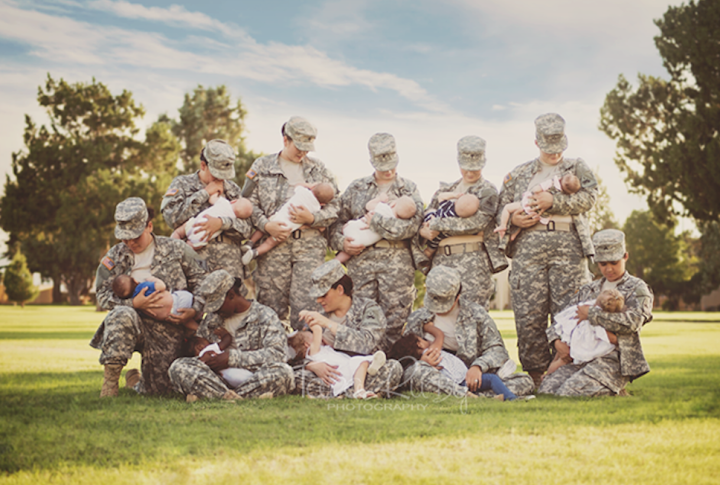
More than a decade later, times have changed, and so have the facilities. At Fort Bliss in El Paso, Texas, a nursing room has been established in the Army base. While it may seem like a small gesture, it is in many ways a major recognition of a unique bonding experience between a woman and her child — one that juxtaposes the often hard exterior of the military with one of the most tender moments in human life. In honor of the new room, Ruby, now a photographer, decided to create “portraits of uniformed soldiers breastfeeding their children.” The striking photos have since gone viral, and serve as a beautiful and inspiring reminder that being feminine and maternal can and indeed does coexist with the strength, duty, and honor that are more often associated with the military than with motherhood.
One of the photographs Ruby shared on Facebook has now received nearly 12,000 likes and 9,000 shares. In her post, Ruby writes, “Today I believe we made history. To my knowledge a group photo to show support of active duty military mommies nursing their little’s [sic] has never been done. It is so nice to see support for this here at Fort Bliss.” Numerous supporters have applauded Ruby’s seamless normalization of a natural process in the context of what is generally considered an uber-masculine, rough and tumble environment that has had its fair share of controversy when it comes to gender as a whole.
“Through the guidance of my military friends, the Fort Bliss P3T Program and Brestfeeding in Combat Boots, our Garrison command and our Public Affairs, we were able to show that even our mommies in uniform can provide for their babies,” she says. “Breastfeeding their babies doesn’t make them less of a soldier, I believe it makes them a better one. Juggling the tasks and expectations of a soldier, plus providing for their own in the best way they possibly can, makes (these) ladies even stronger for it.”
Ever the loyal servicewoman, Ruby was sure to note that the current policies in place are supportive of working military moms, telling CNN, “I think it’s great the Army is supporting active duty mothers.” Still, she notes, “Sometimes, you hit a point in your military career where you have to choose between being a soldier and a mother, and a photo like this helps mothers so they don’t have to choose.”
While Facebook initially removed the photo (much to the chagrin of the many individuals who’d reposted and shared the image), Ruby has managed to sidestep the rather absurd no-breastfeeding policy at
In any case, the real issue at hand is the display of support such photographs represent for working mothers who put their lives on the line for not only their children, but for their fellow countrymen and women every single day. And if that’s not worth celebrating, I don’t know what is.
Editors' Recommendations
- Lockheed Martin wants to build a military 5G network, have the U.S. pay for it
- 5 alternatives to Instagram and Facebook for photographers
- The U.S. Army is developing A.I. missiles that can choose their own targets
- U.K. military is getting serious about lasers and other energy weapons
